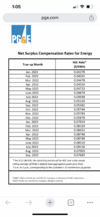If I recall, you have 4 PWs, and your export continues till rather late. My single PW on EE dumps early during the peak period starting at 4pm, and at up to 5kW export, is down to my 20% reserve before 6. So, in my case, the more common 6-9 VPP event is a period during which I usually export none. With 10 events per year, up to $20 each, it can be up to around $200, paid by check from Tesla next year. Not game changing, but not nothing.
About the export limit, there are two different ones. Each month you are limited to NEM credit on only as many kWh of export as PG&E estimates your solar can produce. This is likely only exceeded if one does a bunch of grid charging. The limit more relevant to VPP is the kW limit, the rate at which you can export. I gather this is set to match your maximum solar export rate, and is set so that you don't overload the PG&E transformer, which you probably share with some neighbors. It is a calculation PG&E does before granting permission to turn on your solar. They limit your PW export to the same number, it appears. I think this is then set by Tesla in the PW commissioning process. Oh, there can a third limit on exports which changes the true-up if it exceeds imports, i.e. net generation, but this is not a factor for you, I think.
I think you have a solar max output lower than your 4 PWs can do, so the export rate limit is making your EE take longer. I don't know if it is possible to get PG&E and Tesla to increase your export rate limit, but if so it might let your routine EE export finish before 6, and so give you VPP credit on more of your export.
As I've said before, optimizing PW to maximize the economic benefit is strongly dependent on each situation. Solar size, PW size, shading, rate plan, NEM1 vs 2 or 3, home consumption, ambient temperature, dust on solar panels, etc, etc, etc. So general rules of thumb won't work for everyone.
Just a thought here: Assuming you can't get your export rate limit raised, you may want to consider adjusting your backup reserve setting during these few hot months when VPP may occur. Here's my thinking: Your NEM credits may wind up lower than your NBC's, in which case exporting more during peak times won't actually help you on your true-up. I'm not sure of this yet, but I suspect the trying to get your cumulate NBCs and your NEM equal to each other may be your optimum. EE increases both NBCs and NEM credits, the latter being larger, but all night long you accrue NBCs. So, decreasing the amount of EE, which is limited by your backup reserve, may be how to control the balance between NBCs and NEM credit. Again, once your NEM credits take the net charges and credits below the cumulative NBCs, the NBCs become the basis of your true-up, so increasing the NEM credits gives no benefit. But VPP credit is independent of NEM true-up, so adjsting your reserve down during actual events will get you more $2/kWh credits, while setting the reserver higher when no VPP event is active will decrease EE exports during the same period on "normal" days. Like I said, just a thought.
Again, hats off to you YRide for deep diving into this! This is still before you get your first B/W bill, not to mention a true-up. Most folks ignore all this till they get smacked with a year's worth of ignoring the fine print. For example, a friend, who is probably the smartest person I know, recently got an $1,800 true-up bill. I pointed out that if he reduced his backup reserve to 30% from 60% it would probably reduce the next bill by half, and with 2 PW's, 30% backup would cover his worst case outage just fine, at least during the summer months when PSPS shutdowns are most likely. (Your 5% backup at first surprised me, till I noticed that your 4 PWs made that the same as my 20% on my one.) Anyway, kudos to you.




